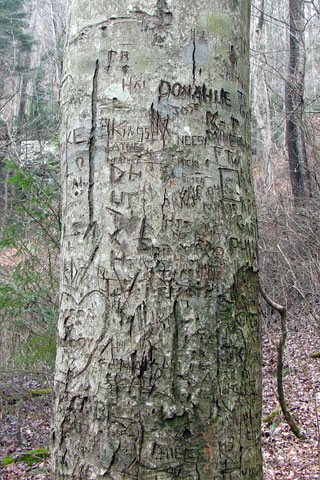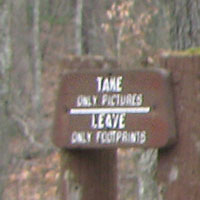| 578 | State of the Parks | 2012-02-14 |

Recently, I have visited three parks throughout the state. All three areas seemed very popular and well used. If anything, they were over used.
My observations from the parks:
Park A - The first three miles of trail led to a waterfall. The trail was unblazed. Users had walked everywhere. Instead of it being a single trail, it was more like an area with a labyrinth of trails. Shortcuts led to everywhere. In several sections it was hard to know if you were following the real trail or not.
Park B - The trail was blazed; but it crossed a wet section. The users instead of getting their boots muddy, they found dry places to walk. The path had grown from being three foot wide to a 12 foot wide mud zone.
Park C - The trail was in relatively good condition; but the camping areas were abused. A tree close to a point of interest had hundreds of initials carved into it's bark. The designated camping sites were rapidly expanding making large camping areas. And there was no registration or accountability programs for the users.
The land in each park was set aside for users to enjoy - each as a beautiful piece of undeveloped wilderness. The problem is the users of the land do not necessarily know how to use it. The users do not understand their personal impact on the environment.
 Perhaps, there needs to be criteria set up for the users. By only allowing accredited users into each designated land area we could save the pristine nature of the most important lands.
Perhaps, there needs to be criteria set up for the users. By only allowing accredited users into each designated land area we could save the pristine nature of the most important lands.
Well, that's an idea; but most folks are not yet ready for such restrictions. We want our personal freedoms - freedom to romp and roam.
So what can be done now to help the special lands? Here are a few tips ...
Continue to support youth education programs, such as the Tennessee Junior Ranger Program, Scouts, YMCA, and other such programs.
Promote Leave No Trace, or similar, programs in the parks. The cost of the programs would probably be offset by the savings from having less trail and campsite maintenance.
In certain National Parks, in order to obtain a hiking or backpacking permit to special areas, the users must first watch a video or attend a class stressing minimum impact.
Make and maintain better trails. Trail work is never finished. Well constructed trails keep the hikers on the paths. Park crews and volunteer crews are needed to maintain the trails.
Trailhead kiosks are a tool. The only people who read the information might be the ones that already know it; but still it is a communication tool.
Self-registration boxes can also be effective. Some of the registrations even require that the users acknowledge the rules governing usage tot he area. Many of the boxes we saw last summer in Colorado, had no papers left inside. The boxes had not been attended in quite awhile.
Experienced hikers should always follow the rules and be examples to others.
Give money, time, or other services to the parks. Though government funded, the parks always seem to be one of the first programs whose funds are slashed by budget cuts. Parks are expensive to operate and maintain. The parks need you to help make them better.
It's Valentines Day. Remember, the parks are for nature lovers.
Happy park trails